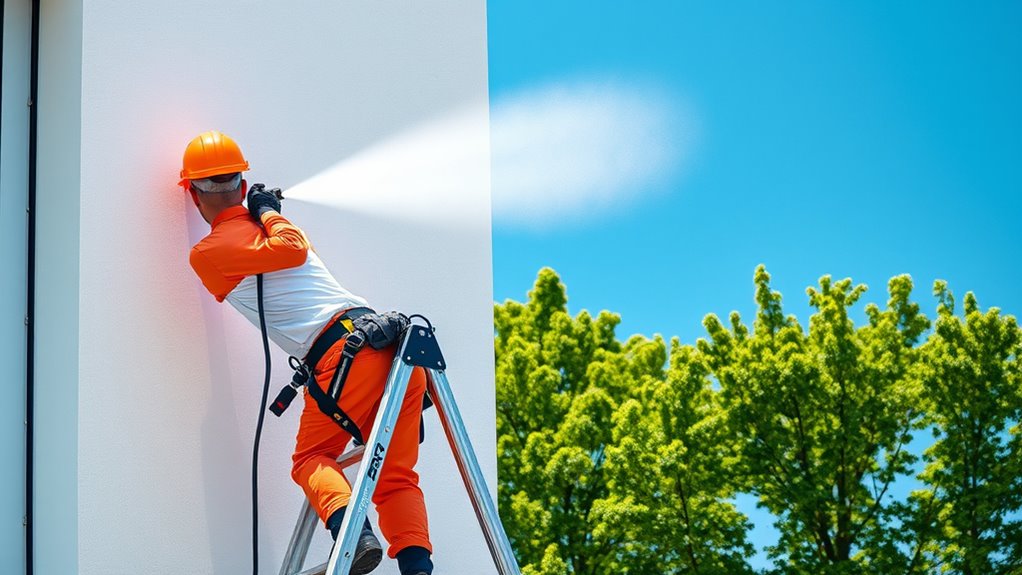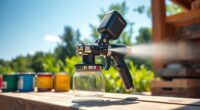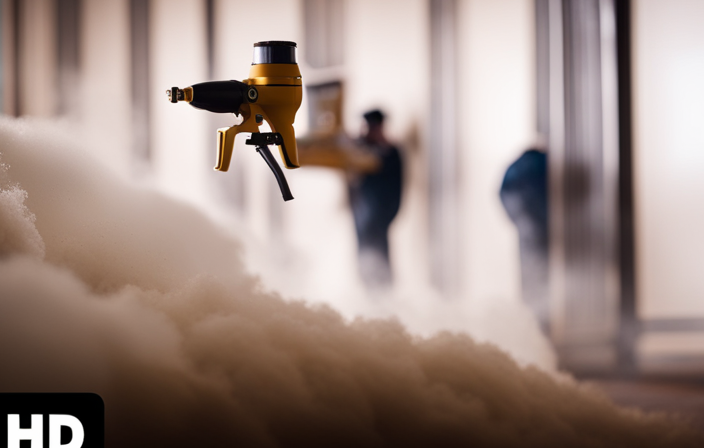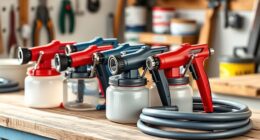To spray paint tall exterior walls safely, start by preparing your workspace: clear debris, protect surrounding areas, and assess the wall’s texture and weather conditions. Use proper equipment like extension poles and adjustable spray guns, and always wear safety gear such as harnesses, goggles, masks, and gloves. Set up barriers and ensure ladders or scaffolding are secure. Monitoring the weather and clean the equipment thoroughly after work will help guarantee a successful, safe project—learn more to master each step effectively.
Key Takeaways
- Use extendable poles and compatible nozzles to reach high walls safely and evenly.
- Secure scaffolding or ladders on stable ground; always follow manufacturer safety guidelines.
- Protect surrounding areas with drop cloths and barriers to prevent overspray and hazards.
- Wear appropriate personal protective gear, including respirators, goggles, gloves, and fall harnesses.
- Monitor weather conditions; avoid spraying during wind, rain, or high humidity for safety and quality.
Assess the Area and Prepare Your Workspace
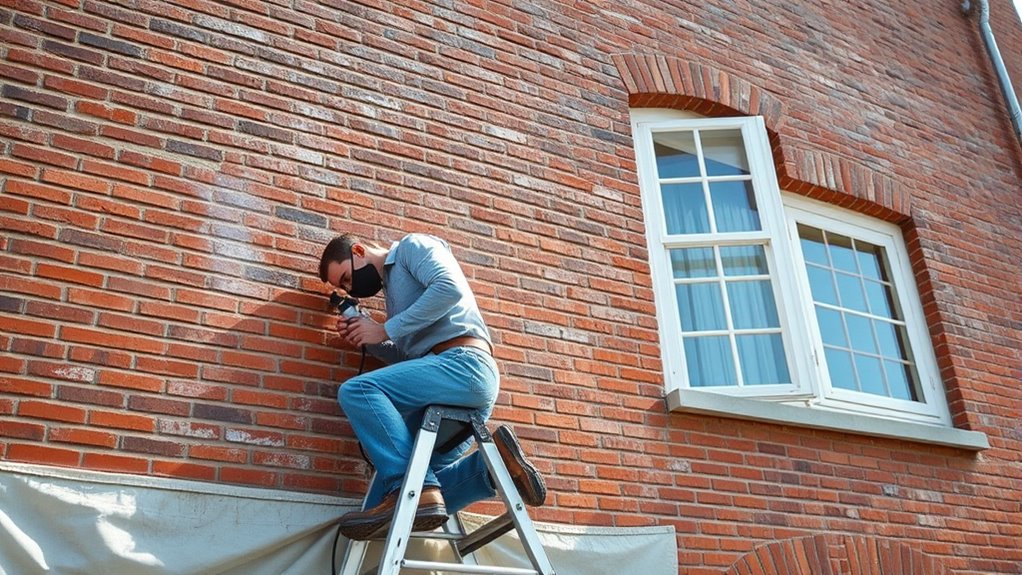
Before you begin spray painting tall walls, it’s essential to assess the area and prepare your workspace thoroughly. Check the surface texture of the wall, as rough or uneven surfaces may require different spray techniques or additional primer. Consider weather conditions; avoid painting on windy, rainy, or excessively humid days, as weather considerations can affect paint adhesion and drying times. Clear the area of debris, furniture, or obstacles that could interfere with your work or pose safety risks. Protect nearby plants, walkways, and windows with drop cloths or plastic sheeting. Ensure the workspace is well-ventilated to prevent fumes from accumulating. Additionally, understanding paint for exterior walls can help you select the right materials for durability and safety. Proper surface preparation techniques can significantly improve the quality and longevity of your paint job. Using appropriate spray equipment can also help you achieve a more even coat and reduce overspray. Employing correct safety precautions such as wearing protective gear and securing ladders are essential to prevent accidents during the process. Taking these steps helps create a safe, efficient environment for spray painting tall walls and ensures a quality finish.
Choose the Appropriate Equipment and Safety Gear

To guarantee a smooth painting process, you need to select the right spray tools for the job. Always wear protective clothing to guard against paint splatters and fumes, and use safety harnesses when working at heights. Proper equipment and safety gear are essential for both quality results and your safety. Additionally, understanding advanced safety protocols can help mitigate risks associated with high-elevation work. Recognizing the importance of Mazda Tuning can also contribute to a positive experience when working on projects involving pets or outdoor environments.
Select Proper Spray Tools
Choosing the right spray tools is essential for achieving a smooth, professional finish on tall walls. Start with the spray gun selection, guaranteeing it matches the type of paint and the height you’re working at. A high-quality spray gun with adjustable settings helps control paint flow and spray pattern, giving you better coverage and finish. Pay close attention to nozzle compatibility; different nozzles produce various spray patterns and thicknesses. Using the correct nozzle size ensures even application and reduces overspray. Consider a spray gun with a longer hose or an extension pole to reach high areas comfortably. Proper tools make your job easier and safer while helping you achieve a consistent, flawless result on those tall exterior walls. Additionally, selecting appropriate safety gear such as masks, goggles, and protective clothing is crucial to safeguard yourself from paint fumes and overspray during high-reach spraying projects. Incorporating professional-grade equipment can further enhance safety and efficiency, especially for large or complex projects. Using suitable equipment also minimizes fatigue and strain during prolonged work sessions, ensuring better control and safety throughout your project. To optimize your results, it’s also beneficial to understand paint viscosity and how it affects spray performance, especially when working at heights.
Wear Protective Clothing
When spray painting tall walls, wearing the right protective clothing is crucial to safeguard your health and guarantee a clean work environment. Choose safety gear like coveralls or long-sleeved shirts and pants to protect your skin from paint splatters and fumes. Safety goggles shield your eyes from overspray, while a respirator or mask prevents inhaling harmful particles. Gloves keep your hands safe from chemicals and paint contact, and a hat or hood offers extra coverage. Make sure all your protective clothing fits well and is made from durable, chemical-resistant materials. Proper safety gear minimizes health risks, helps you stay comfortable, and ensures a more efficient painting process. Additionally, protective equipment such as ear protection and proper footwear can further enhance safety during your project. Ensuring your personal protective equipment is suitable for the specific environment can prevent accidents and health issues. It is also important to ensure proper fit to avoid discomfort and potential hazards during prolonged use. When working outdoors, be mindful of weather conditions as they can impact safety and the effectiveness of your protective gear. Always prioritize your safety by selecting appropriate protective clothing before starting your project. Safety standards should be followed to ensure proper protection during painting.
Use Safety Harnesses
Since working on tall walls involves height and potential fall hazards, using a safety harness is essential for your protection. Choose the right safety harnesses designed for fall prevention, ensuring they fit snugly and are properly secured. Inspect the harness before each use to confirm there are no frays or damage. Attach the harness to a sturdy anchor point that can support your weight and withstand fall forces. Wearing a safety harness keeps you securely anchored, reducing the risk of dangerous falls. Always double-check connections and adjust straps for comfort and security. Proper safety gear is crucial for minimizing injury risk during high wall projects. Remember, fall prevention is vital for safe spray painting on high walls, so never skip or compromise on your safety gear. Proper use of safety harnesses can make all the difference in avoiding accidents. Additionally, understanding safety protocols can further enhance your protection and ensure a safer working environment. Regular training on fall prevention techniques can also improve your confidence and safety awareness when working at heights. Using quality safety equipment from reputable manufacturers can provide added reliability and peace of mind during your projects.
Inspect and Maintain Your Spray Painting Tools
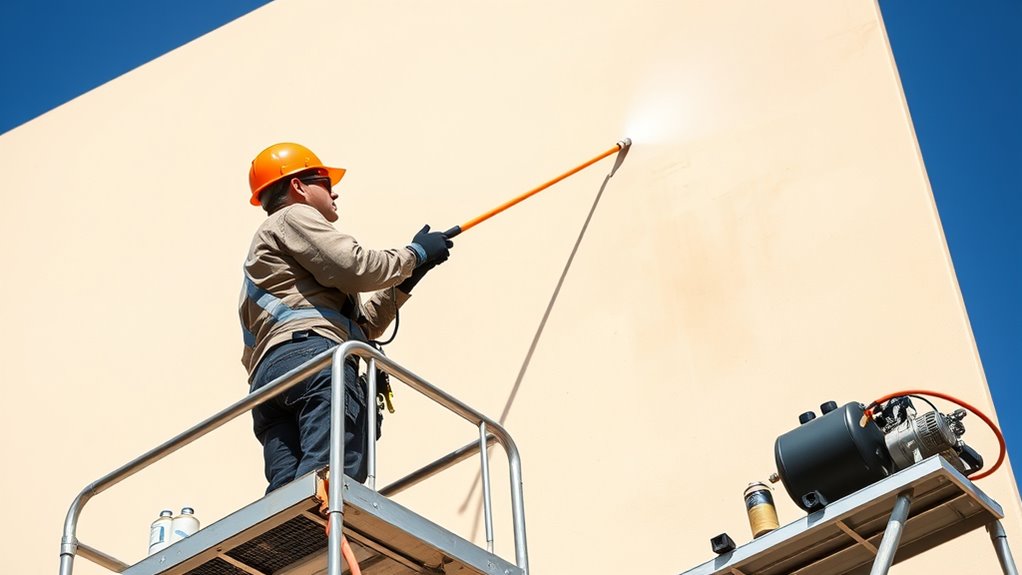
Before you start your spray painting project, it’s vital to inspect and maintain your tools to guarantee peak performance. Begin by checking that your spray gun and compressor are properly calibrated to ensure even paint application. Regular tool calibration prevents uneven coverage and reduces paint waste. Follow a consistent maintenance schedule, cleaning all components thoroughly after each use to prevent clogs and damage. Inspect hoses and fittings for leaks or cracks, replacing any worn parts before starting. Proper maintenance extends your tools’ lifespan and ensures reliable operation, especially when working on tall exterior walls. Additionally, paying attention to tool calibration can significantly improve the quality of your finish. Maintaining proper equipment functionality minimizes interruptions and ensures safety during your project, making your spray painting process smoother and more efficient.
Use Proper Techniques for Even Coverage
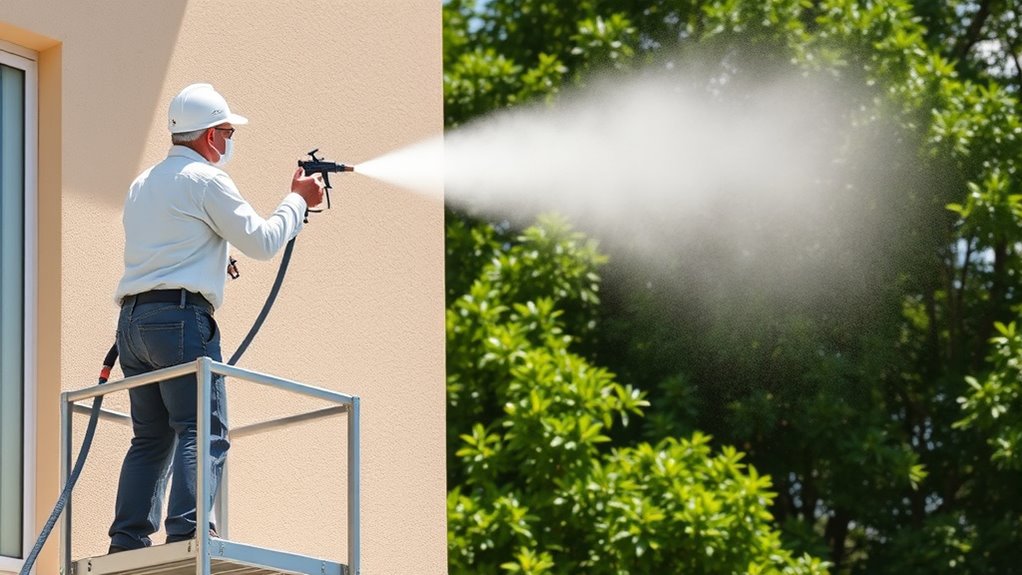
To achieve an even coat on tall walls, it’s essential to use proper spray painting techniques. Consistent technique ensures uniform paint application, preventing streaks or uneven patches. Keep a steady hand and maintain a consistent distance from the surface—usually 10 to 12 inches—while moving smoothly across the wall. Overlapping each pass by about 50% helps ensure complete coverage without excessive build-up. Maintain a consistent speed; rushing or pausing can cause drips or thin spots. Practice your spray pattern on a scrap surface beforehand to confirm you’re applying paint evenly. By focusing on technique consistency and controlled movements, you’ll achieve a professional-looking finish that’s evenly coated and long-lasting.
Secure the Work Area and Set Up Barriers

Before starting, you need to establish a clear perimeter around the work area to keep unauthorized people out. Setting up barriers guarantees safety and keeps your workspace organized. Don’t forget to place warning signs to alert others of the ongoing spray painting.
Establish a Perimeter
Securing the work area is essential to guarantee safety and prevent unauthorized access during the painting process. Establishing a clear perimeter helps keep people at a safe distance and protects your work zone. Use perimeter fencing to create a physical barrier around the area, or place boundary markers like cones or flags to define boundaries visibly. These markers alert passersby and keep pets or children away from hazards. Properly set up your perimeter before starting, ensuring it covers all sides of the wall. Here’s a visual guide:
| Barrier Type | Purpose |
|---|---|
| Perimeter fencing | Physical barrier, durable |
| Boundary markers | Visual cues, easy to move |
| Warning tape | Temporary, signals caution |
| Signage | Informative, instructive |
Use Warning Signs
Using warning signs is a vital step in securing your work area and setting up barriers. Place clear warning signs around the perimeter to alert others to the spray painting activity. These hazard alerts prevent accidental entry into dangerous zones and keep passersby aware of the potential risks. Make sure signs are visible from a distance and positioned at eye level. Use bright colors and bold lettering to catch attention quickly. Properly placed warning signs help create a safe environment by informing everyone of the ongoing work and potential hazards. This simple step reduces the chance of accidents and guarantees that only authorized personnel enter the area. Always double-check that warning signs are secure and legible before starting your painting project.
Work at Heights Safely With Proper Scaffolding or Ladders
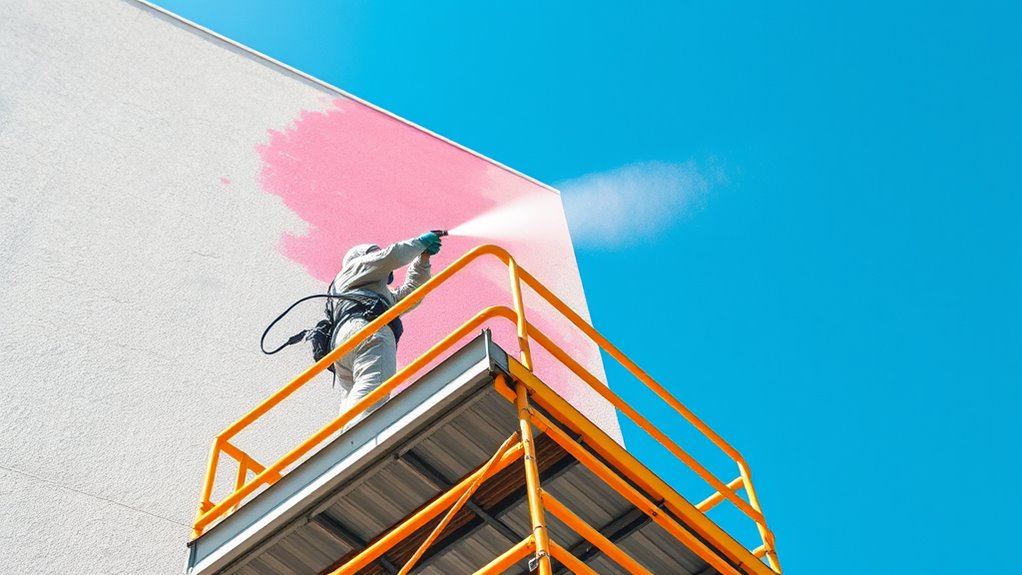
Working at heights requires careful attention to safety, and using proper scaffolding or ladders is essential to prevent accidents. Confirm your scaffolding safety by checking that it’s set up on stable, level ground and that all parts are securely assembled. Regularly inspect for loose or damaged components before use. When using ladders, prioritize ladder stability by placing it on firm, non-slip surfaces and maintaining three points of contact at all times. Never overreach or lean too far to one side, as this can cause falls. Always follow safety guidelines and manufacturer instructions. Properly secured scaffolding and stable ladders reduce the risk of falls, keeping you safe while working at heights on tall exterior walls.
Be Mindful of Weather Conditions and Timing
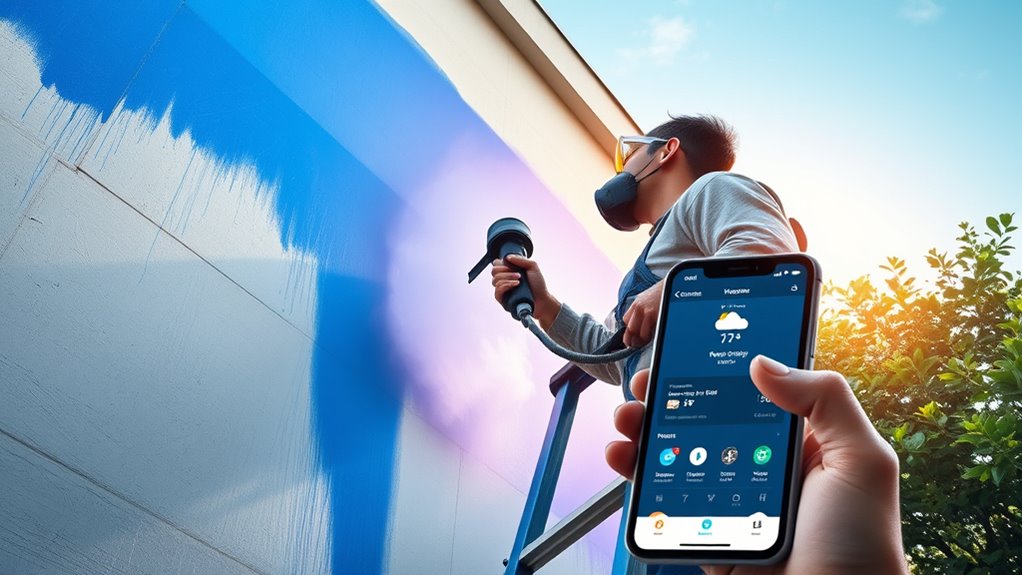
Being mindful of weather conditions and timing is essential for spray painting tall walls, as adverse weather can compromise the quality of your work and safety. Weather considerations like wind, rain, and extreme temperatures affect how paint adheres and dries. Spray painting on a windy day can cause overspray and uneven coverage, while rain can wash away fresh paint. To guarantee the best results, plan for the most favorable timing by checking weather forecasts and choosing days with mild, dry conditions. Early mornings or late afternoons often offer calmer winds and more stable temperatures. Avoid painting during high humidity or when rain is imminent, as these factors can lead to drips, runs, or poor adhesion. Staying attentive to weather helps you achieve a smooth, durable finish safely.
Follow Safe Disposal and Cleanup Procedures

To guarantee safety and environmental responsibility, it is vital to follow proper disposal and cleanup procedures after spray painting tall walls. Proper waste disposal involves safely collecting and disposing of leftover paint, solvent containers, and used rags according to local regulations. Never pour paint or solvents down drains or onto the ground, as this can harm the environment. During cleanup procedures, thoroughly clean your spray equipment and brushes, ensuring no leftover paint remains. Use appropriate solvents and dispose of them properly. Wear gloves and masks to protect yourself during cleanup. Keep your work area tidy by removing debris and unused materials promptly. Following these steps minimizes environmental impact and ensures a safe, responsible spray painting process.
Frequently Asked Questions
How Do I Prevent Overspray on Surrounding Surfaces?
To prevent overspray on surrounding surfaces, you should use drop cloths to cover the ground and nearby objects. Masking tape is essential for protecting edges and trims from paint. Apply the tape carefully to create clean lines, and secure the drop cloths firmly. This way, you’ll keep your work area protected, ensuring that overspray doesn’t ruin nearby surfaces, and your painting project turns out neat and professional.
What Are the Best Methods to Handle Unexpected Weather Changes?
Did you know that weather forecasting accuracy has improved by 85% in recent years? When unexpected weather hits, you should rely on updated forecasts to plan your work. Cover nearby surfaces with protective coverings, and if rain is forecasted, pause your project until conditions improve. Always have a plan B, like moving your work to a sheltered area, to keep your project safe and guarantee a quality finish.
How Can I Ensure Even Paint Application on Textured Walls?
To guarantee even paint application on textured walls, focus on proper brush techniques and maintaining the right paint consistency. Use a high-quality brush suited for textured surfaces, applying the paint in a controlled, sweeping motion to reach crevices. Keep the paint mixture consistent, avoiding thin or thick spots, and work in small sections. This approach helps you achieve a smooth, uniform finish even on challenging textured surfaces.
What Steps Should I Take if a Ladder or Scaffold Becomes Unstable?
If your ladder or scaffold becomes unstable, prioritize ladder safety and scaffold stability immediately. Carefully descend and reposition the ladder or scaffold on a level, solid surface. Check for any damage or loose parts before resuming work. Always guarantee your ladder is at the correct angle and secure the scaffold with safety locks or braces. Never overreach; move the ladder or scaffold closer to your work area to maintain balance.
How Do I Protect Nearby Plants and Landscaping During Painting?
A stitch in time saves nine, so protect your plants from paint splatters. You should set up plant barriers or shrub covers around your landscaping to shield them from overspray. Use painter’s tape and plastic sheeting for delicate areas, ensuring they’re secure. This way, you prevent damage and keep your garden pristine, even when spray painting tall exterior walls. Remember, careful preparation makes the job safer and cleaner.
Conclusion
By following these safety tips, you’ll master spray painting tall exterior walls without turning a simple project into a disaster. Always prioritize your safety, prep thoroughly, and use the right gear—think of it as shield armor against chaos. With careful planning and vigilance, you’ll conquer even the tallest surfaces like a painting superhero. Remember, safety isn’t just important—it’s your secret weapon to guarantee a flawless finish and a job that’s truly legendary!
